
Zaebos is a demon or spirit mentioned in the Dictionnaire Infernal . It is described as the Grand Count of the infernal realms and is said to appear in the form of a handsome soldier mounted on a crocodile. [1]

Zaebos is a demon or spirit mentioned in the Dictionnaire Infernal . It is described as the Grand Count of the infernal realms and is said to appear in the form of a handsome soldier mounted on a crocodile. [1]
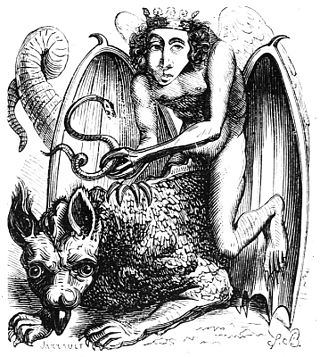
Astaroth, in demonology, is known to be the Great Duke of Hell in the first hierarchy with Beelzebub and Lucifer; he is part of the evil trinity. He is known to be a male figure, most likely named after the Near Eastern goddess Astarte.

Aamon, in demonology, is a Grand Marquis of Hell who governs 40 infernal legions, and the 7th spirit of the Goetia. He is the demon of life and reproduction.

Bael is a demon described in demonological grimoires such as The Lesser Key of Solomon and the Pseudomonarchia Daemonum and also in the Dictionnaire Infernal. He is described as a hoarsely-voiced king with the power to make men invisible and ruling over sixty-six legions of demons. The Lesser Key of Solomon describes him as appearing in the form of a cat, toad, man, some combination thereof, or other "diverse shapes", while the Pseudomonarchia Daemonum and the Dictionnaire Infernal state that he appears with the heads of a cat, toad, and human simultaneously.

In demonology, Beleth, also spelled Bilet, Bileth, Byleth, or Bilith, is a king of Hell who has eighty-five legions of demons under his command. He rides a pale horse, and a variety of music is heard before him, according to most authors on demonology and the most known grimoires.
In demonology, Halphas is the thirty-eighth demon in the Ars Goetia in the Lesser Key of Solomon, ranked as an earl.
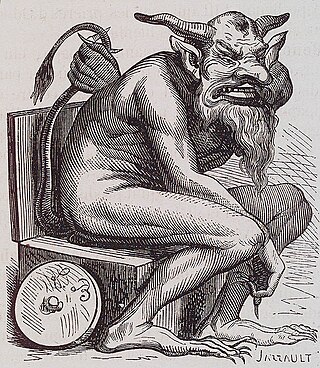
In Jewish demonology, Belphegor is the Arch-devil. In qabalah, Belphegor is a demon who helps people make discoveries. He seduces people by suggesting to them ingenious inventions that will make them rich, stagnating that which could not be accredited to itself.
In demonology, Morax is a Demon, Great Earl, and President of Hell, having thirty legions of demons under his command. He teaches Astronomy and all other liberal sciences, and gives good and wise familiars that know the virtues of all herbs and precious stones. This profile of the demon can be seen in Pseudomonarchia Daemonum as well as in Goetia.

There have been various attempts at the classification of demons within the contexts of classical mythology, demonology, occultism, and Renaissance magic. These classifications may be for purposes of traditional medicine, exorcisms, ceremonial magic, witch-hunts, lessons in morality, folklore, religious ritual, or combinations thereof. Classifications might be according to astrological connections, elemental forms, noble titles, or parallels to the angelic hierarchy; or by association with particular sins, diseases, and other calamities; or by what angel or saint opposes them.
In some occult and similar writings, an archdemon, archdevil, or archfiend is a spiritual entity prominent in the infernal hierarchy as a leader of demons. Essentially, the archdemons are the evil opponents of the archangels.

Xaphan is one of the fallen angels that rebelled with Satan against God, and is a demon of the 2nd rank.
In European mythology and literature since at least the 19th century, a cambion is the offspring from the union between a demon parent--whether incubus, succubus or other type of demon--with a human parent. In the word's earliest known uses, it was interchangeable with changeling.
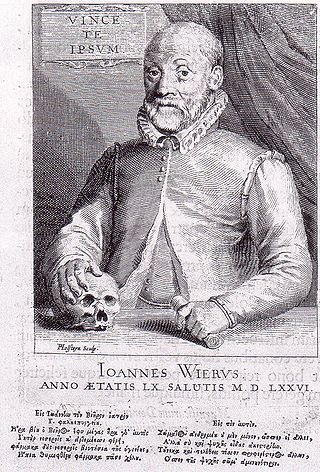
De praestigiis daemonum, translated as On the Tricks of Demons, is a book by medical doctor Johann Weyer, also known as Wier, first published in Basel in 1563. The book argues that witchcraft does not exist and that those who claim to practice it are suffering from delusions, which should be treated as mental illnesses, rather than punished as witchcraft. It was influential in the abolishment of witchcraft trials in the Netherlands.

The Dictionnaire Infernal is a book on demonology, describing demons organised in hierarchies. It was written by Jacques Collin de Plancy and first published in 1818. There were several editions of the book; perhaps the most famous is the 1863 edition, which included sixty-nine illustrations by Louis Le Breton depicting the appearances of several of the demons. Many but not all of these images were later used in S. L. MacGregor Mathers's edition of The Lesser Key of Solomon.
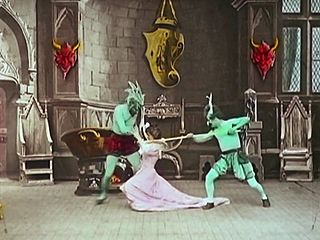
Le Chaudron infernal, released in Britain as The Infernal Cauldron and in the United States as The Infernal Caldron and the Phantasmal Vapors, is a 1903 French silent trick film directed by Georges Méliès. It was released by Méliès's Star Film Company and is numbered 499–500 in its catalogues.
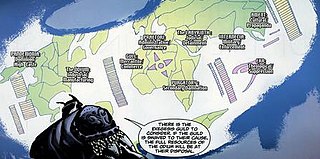
Hell is a fictional location, an infernal Underworld utilized in various American comic book stories published by DC Comics. It is the locational antithesis of the Silver City in Heaven. The DC Comics location known as Hell is heavily based on its depiction in Abrahamic mythology. Although several versions of Hell had briefly appeared in other DC Comics publications in the past, the official DC Comics concept of Hell was first properly established when it was mentioned in The Saga of the Swamp Thing #25–27 and was first seen in Swamp Thing Annual #2 (1985), all of which were written by Alan Moore and illustrated by Stephen Bissette and John Totleben.
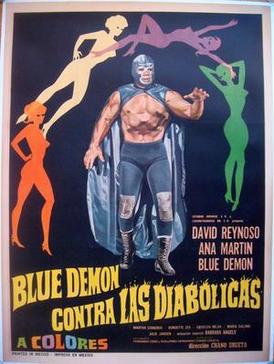
Blue Demon contra las diabólicas is a 1966 Mexican horror film. It was directed by Chano Urueta and stars David Reynoso, Ana Martín and the wrestler Blue Demon.
Les Trésors de Satan, released in the United States as The Treasures of Satan and in Britain as The Devil's Money Bags, is a 1902 French silent trick film directed by Georges Méliès. It was released by Méliès's Star Film Company and is numbered 413–414 in its catalogs.
José Antonio Rojas is a Mexican professional wrestler best known under the ring name Demonio Infernal. He is a second-generation wrestler, son of Guillermo Martinez Cid, best known as Bombero Infernal and the brother of wrestlers Matrix Jr., Muerte Infernal, Capitain Muerte and La Bomberita. Rojas made his in-ring debut in 2012, using the name Demonio Imperial.

Le Cake-Walk infernal, sold in the United States as The Cake Walk Infernal and in Britain as The Infernal Cake Walk, is a 1903 French silent trick film by Georges Méliès. It was sold by Méliès's Star Film Company and is numbered 453–457 in its catalogues.